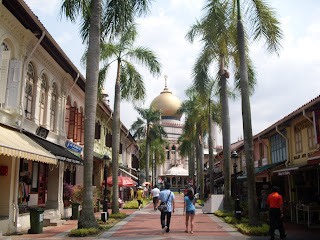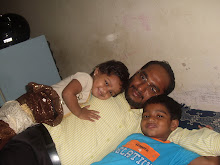 In the Malabar mosque my friends were waiting for me with the tea to discuss the day’s plan. It was interesting to see that the tea meant for me was kept suspended on the wall in a plastic bag, of course, but sorry to say, you will mistake it for a urine bag in hospital, and while seeing it for the first time suspended on the mosque wall, I wondered why this people have attached it in the mosque. Later I noticed that carrying tea or coffee, both hot and cold, in plastic bags and drinking it using straws is a common thing in Southeast.
In the Malabar mosque my friends were waiting for me with the tea to discuss the day’s plan. It was interesting to see that the tea meant for me was kept suspended on the wall in a plastic bag, of course, but sorry to say, you will mistake it for a urine bag in hospital, and while seeing it for the first time suspended on the mosque wall, I wondered why this people have attached it in the mosque. Later I noticed that carrying tea or coffee, both hot and cold, in plastic bags and drinking it using straws is a common thing in Southeast.A Walk through Singapore Muslims’ History
We set out for a morning walk through the Kampong Glam Muslim quarters. Starting from the busy Victoria Street and Jalan Kubur, we passed through Bugis to cross over and reach the story-telling streets named after Muslim cities - Arab Street, Basra Street, Baghdad Street, Muscat Street and Kandahar Street - ending at the imposing Sultan mosque and the Jalan Sultan where my first morning walk, which was exactly a journey to the Muslim past of the Singapore, ended with a delicious cuisine at a Malabari’s hotel.

Along with Imam Shafeeq Hudawi
Jalan Kubur is a small road with a grand and spacious cemetery of mainly Sultans and their relatives at one side and a public Muslim cemetery that is no longer in use on the other. Kampong means Village or settlement in Malay, while Glam is in reference to the Gelam tree, a variety of eucalyptus that was abundant in the area and the bark of which was used by Bugis sailors and boat builders in the Kampong to seal gaps in their bots, while its leaves have the medicinal value. The Malay aristocracy lived in the area before the British East India Company signed a treaty with Sultan Hussein Shah of Johor and Temenggong Abdul Rahman to set up a trading post in 1819. In 1822, when Raffles drew the city’s sketch, he divided the settlement among different ethnic groups like European Town, Chinese, Chulia, Arab and Bugis kampongs. He designated Kampong Glam for the Sultan and his household, in addition to the Malay and Arab communities.

Basra street leading to Sultan mosque
As a result of government’s policy interventions aimed at abolishing village settlements and eliminating ethnic congregation in certain areas, the Kampong Glam is now left with historical symbols as well as heritage shopping and eating, to tell the tale of its past. However, the government is extra conscious to preserve the buildings and streets in its true colours. Since the 1980s, several large portions of the area have been declared National Heritage sites and have been protected for conservation. In 1989, the Urban Redevelopment Authority gazetted Kampong Glam, including the Sultan Mosque, the Hajjah Fatimah Mosque and the Istana Kampong Glam, the palace of the former Sultan, as a conservation area. Moreover, the area is still a key landmark and gathering point for Singapore Muslims and it is for them, especially the Malays, what Chinatown for Chinese and Little India for Indians. The palace of Sulatan (Istana Kampong Glam ) is a heritage museum, the Malay heritage Centre, now showcasing the rich history and culture of Singapore’s Malay community.

Arab street
Sultan Mosque
 Imam Shafeeq and Imam Rafeeq took me to the historic Sultan mosque, a key building and tourist attraction at the end of Bussorah Street. Largest mosque in Singapore with a 5,000 capacity for congregational prayers, the golden domed mosque has many laurels in its credit. It is the only mosque that can use a megaphone outside the mosque for the ceremonial call to the prayers and other programs. Other mosques too use the megaphone, but the sounds should be limited to the compound.
Imam Shafeeq and Imam Rafeeq took me to the historic Sultan mosque, a key building and tourist attraction at the end of Bussorah Street. Largest mosque in Singapore with a 5,000 capacity for congregational prayers, the golden domed mosque has many laurels in its credit. It is the only mosque that can use a megaphone outside the mosque for the ceremonial call to the prayers and other programs. Other mosques too use the megaphone, but the sounds should be limited to the compound.The mosque was materialized when Sultan Hussein, while signing the treaty with Raffles, negotiated to build a mosque near his palace, and the later even contributed $3000 Spanish dollars to its construction. Early in the last century the initial building underwent a reconstruction, thanks to the new design of British planner Dennis Santry who shaped the mosque in the Islamic Saracenic style with domes, minarets and balustrades. According to the information provided by tourist guides at the mosque, designs from Taj Mahal, style from Persian, Moorish, Turkish and a classical theme have been incorporated in the new structure that was completed in 1928.
 Along with Imam Rafeeq Hudawi in front of Sultan Mosque
Along with Imam Rafeeq Hudawi in front of Sultan MosqueI returned to a kind of spiritual and traditional fragrance of these streets many times alone during my stay in Singapore in order to get socked in the feeling of being there a hundred or some years ago bargaining with the traders and merchants from all over the world, exchanging great cultures. What an enchanting mood was it while walking through the beautifully restored outlets selling traditional clothes and Malays medicines, artefacts, handicraft, furniture, jewelry, restaurants in addition to an extremely fitting bookshop that sells mostly sufi-oriented classic books and CDs. Muslims generally buy their headgear (or songkok), the holy Quran, prayer mats and manuals from here.
Murtabak At Zamzam
Now both the imams take me into Zamzam restaurant, one of the major destinations for tasty Halal foods, along with Victory and others. Started in the early 20th century, Zamzam is owned by a Malayali family from Kannur district of North Keala, and most of its workers are also from Kerala. As I entered the restaurant accompanying the Imams of the mosque, to whom the hotel sends packed foods many times a month, I got a privileged treatment. Makan ah? . (makan is food and the suffices like ah, lah and leh is a part of Singlish which is a mix of Malay, Mandarin, Tamil and all) They decided to let me have the taste of the special Murtabak, a must-try item in Southeast Asia, of course with all its regional varieties.
 The delicious murtbak placed aesthetically
The delicious murtbak placed aestheticallyI wonder hearing the claims that Murtabak is a Malabari cuisine. For Malayalis it is easy to understand that the initial ingredient is the big ball of our Poratta, that egg-sized lump which becomes a large and smooth sheet in about the spade of a minute in the hands of an expert poratta maker. Now without cutting it, unlike what we do to make our poratta, the smooth sheet is stuffed with ground or minced mutton or chicken, chopped coriander leaves, sliced onions and beaten egg along with some other ingredients. The draped stuff will be then put in an oven to serve hot after a short time alone or along with a sauce and gravy.
 tourists at Sultan mosque
tourists at Sultan mosqueIn Indonesia I was served with multiple varieties of Murtaba bearing different tastes, and they have special murtaba belonging to various regions and islands, like murtaba Bandung, and they have the sweat variation of Murtaba as well. ‘Food historians’ debate the Malayali origin of Murtaba, and a googling traces its ancestry into Arabia, especially the Higaz region of Saudi Arabia. Friends there should verify this. It says Murtabak is Mutabbaq in Arabic (مطبق) or mutabbag meaning ‘folded’. There is also an opinion that Martabak originated in India, during the Delhi Sultanate and traders took it with them to Southeast Asia. However, to those who still value the oral history, many of my hosts wondered, whenever they served me with Murtabak, saying that how come I don’t know a food with Malabari origin.
Now I could put a full stop thinking that as neo Malayalis carried away the bugs while migrating, the old migrants carried Murtaba away and left no trace of it back in Kerala. Moreover, I got a point for my research, a historic common Arabian or Persian origin for our porotta and their Murtaba.
 Inside Sultan Mosque
Inside Sultan Mosque
